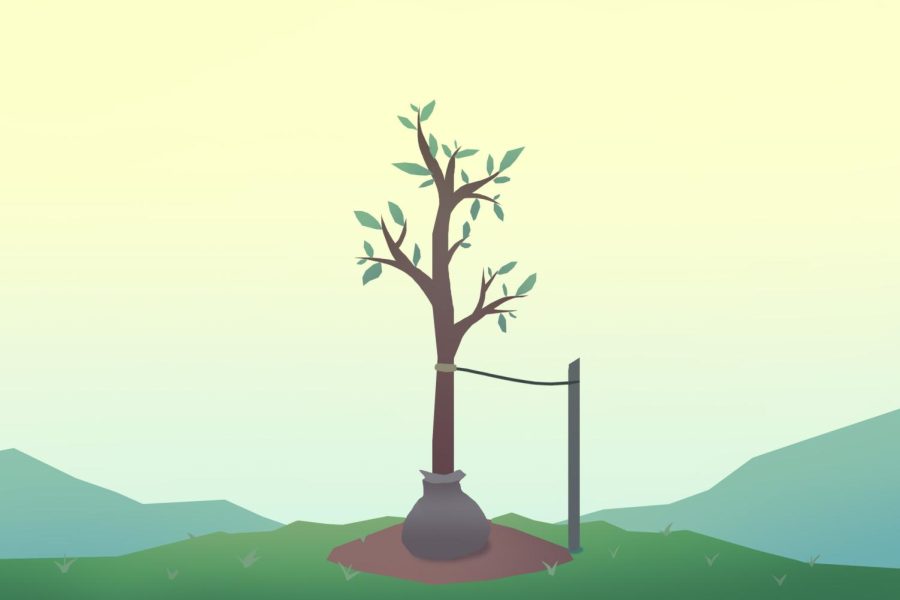Tree Montgomery: A free program bringing benefits to Montgomery County through shade trees
Just this past planting season, Tree Montgomery planted over 3,800 trees, Forest Conservation Coordinator Laura Miller said.
June 1, 2023
Employees walk into a neighborhood home’s backyard, carefully transporting a small maple tree ready to be planted in the rich, nutrient-filled brown soil. The sun beams brightly as the sapling sits in its new home. Over the coming years, the young tree will age alongside its owners, eventually reaching a majestic and towering height with branches filled with lush green leaves.
Tree Montgomery is a program that plants free saplings across the county to provide lasting environmental and social benefits. Many of these benefits, like less runoff, are best seen when multiple shade trees are grown in one area, referred to as the tree canopy. After Montgomery County passed the Tree Canopy Law in 2013 to expand the tree canopy, Tree Montgomery was launched.
The law attempts to mitigate environmental disturbance on construction sites and protect the county’s tree canopy. The law states that if construction projects require a sediment control permit, shade trees must be planted in accordance with the amount of square footage affected by the project. If the applicant can’t plant a shade tree, they must pay a fine to the Tree Canopy Conservation Fund. Money from this account is then used to fund reforestation and transplanting projects and programs like Tree Montgomery.
Tree Montgomery plants across various requested locations, including homes, parks, schools and businesses. The program plants trees that have been growing for four to ten years, depending on the species, Forest Conservation Coordinator Laura Miller said. Miller manages many tree programs across the county, including Tree Montgomery.
“Our big goal is to put the right tree in the right place so that it’s there for 50 or more years.” Miller said. “We really want great big tall trees to provide shade.”
The program provides excellent and healthy trees, according to Terri Payne, a participant of Tree Montgomery in the Whitman area. Payne requested trees in October 2021 and had a Sweetgum and a Sugar Maple planted in February 2022. She was pleased with the quality of the trees and recommended the program to others.
“They’re tall and straight and healthy and vigorous and [show] no sign of insect damage or anything else,” Payne said. “These were very high-quality trees that the county purchased.”
The process is straightforward: residents request a tree, and the organization places them on a waiting list. Once they’re at the front of the queue, a staff member will come to the property and discuss tree species and planting location options with them. Planters have to consider the amount of light and other activities in the area when discussing possible tree options with applicants, Payne said. After participants sign the Right of Access Agreement, they’re added to the Tree Montgomery schedule for their tree to be planted.
The program obtains saplings from various tree nurseries, primarily in central Virginia. Planting occurs during the fall, winter and spring through contractors working with Tree Montgomery. After planting the tree, an employee from Tree Montgomery or the approved contractor will complete a follow-up inspection to ensure the tree was planted properly.
Tree Montgomery participant Amanda Farber, a community environmental activist, noticed a lack of tree canopy in her neighborhood. She wanted to help promote change, so she began volunteering at Conservation Montgomery — a local nonprofit focused on preserving natural resources in Montgomery County and advocating for environmental policy reforms.
Shade trees — large leafy trees that provide plentiful shade — are one of the most effective ways to increase tree canopies. Because of this, Tree Montgomery focuses on planting solely shade trees, which have many benefits, Farber said.
“There’s all these different trees from minor species to major species [that] play a role right in the ecosystem,” Farber said. “But shade trees, you’re talking about significant cooling effects, shade over sidewalks and streets, making them more walkable and livable.”
Studies have shown that shade can lower surface temperature by 20-40 degrees Fahrenheit, and along with cooling effects, shade trees also reduce runoff and filter soil.
For Payne, controlling runoff was a major factor in her decision to participate in Tree Montgomery.
“Shade trees are particularly good at soaking up and retaining all that water,” Payne said. “That was one big motivation, to try to control some of the runoff that was coming down the hill every time it rained.”
According to the Alliance for Community Trees, trees redirect rainwater into the soil where bacteria filter out impurities, helping to reduce the amount of pollutants and sediment that reach larger bodies of water. Trees reduce runoff by 833 million gallons annually in Montgomery County.
Additionally, trees filter the air by absorbing harmful pollutants and greenhouse gasses like carbon dioxide, sulfur dioxide and nitrous oxides. In Montgomery County, trees remove 11,260 pounds of air pollution annually. Both young and old trees are crucial to the environment and mitigating climate change effects, Miller said.
“Another thing that the trees do is sequester carbon by growing and growing and growing,” Miller said. “The younger trees sequester more carbon by growing faster, but the older trees are storing more carbon because there is just a lot more carbon trapped in the volume of wood that’s in them, so both are very important.”
Trees are also a critical part of the infrastructure, Farber said. Although there have always been beliefs that nature complements mental health, scientists are starting to find more data linking the two. Studies have found that trees increase mental health and public safety while decreasing violence and crime rates.
Just this past planting season, Tree Montgomery planted over 3,800 trees, Miller said. The organization has also reduced the waiting period for participants by hiring more staff members. The additional staff allows the program to run smoothly, satisfying more neighborhoods with lasting enjoyment.
“The benefits don’t gradually get bigger as the tree gets bigger, it’s exponential,” Miller said. “As the tree gets bigger, the benefits get way, way bigger.”










